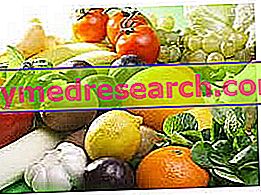What's this
What is canned pineapple?
Pineapple in syrup is a long-life food that belongs to the whole of the preserved fruit and fruit in syrup subset.

The fresh pineapple - the fruit of the tree belonging to the genus and botanical species Ananas comosus - belongs to the VI-VII fundamental group of foods - fruits and vegetables rich in vitamins A and C. Note : the pineapple brings both vitamins though, referring to many other richer fruits, concentrations are not particularly high. Among the energetic macronutrients, they bring above all fructose - which outlines a moderate energy intake; the water is abundant and there is no lack of certain specific minerals of the category, especially potassium. On the other hand, once transformed into "preserves" - washing, peeling, cutting, coring, cooking and potting in a sweet liquid - the vitamin concentration tends to decrease significantly. Moreover, compared to the fresh one, pineapple in syrup is much richer in soluble / simple sugars and calories. This gives you a high glycemic-insulin load; it is therefore not very suitable for clinical nutrition, especially for overweight, type 2 diabetes mellitus and hypertriglyceridemia. Recall that an excess of sugar can promote the formation of tooth decay. Note : in order to improve conservation, in the industrial sector the fruit in syrup is enriched with antioxidant additives - especially vitamin C or ascorbic acid, like the many types of ascorbate.
The pineapple recipe in syrup is quite simple. The steps required to increase shelf life are cooking and sterilizing; taking for granted an adequate heat treatment, the most important step - but also the most delicate - to obtain pineapple in syrup with perfect consistency - even in the long term - is certainly the formulation of the syrup.
In the kitchen, pineapple in syrup is mainly used as a dessert, sometimes accompanied by whipped cream and / or liqueurs and / or chocolate chips and / or biscuits - even crumbled. It is advisable to eat it away from the main meals, in order to avoid too high a glycemic load; it can be a snack or an ingredient for breakfast. Several recipes contain pineapple in syrup even though, generally, they all have in common due to the excessive intake of calories and simple sugars compared to the needs of an ordinary diet; some examples are cakes - especially cold ones - such as cheesecakes - or various desserts - such as frozen desserts.
Why syrup the pineapple?
The invention of syruping is due to the need to prolong the preservation of fresh fruits, excessively available in a limited period of time - that of maturation. Pineapples can also be used to make jellies, candied or dehydrated / dried fruit pieces.
The pineapple is a plant that grows and bears fruit at latitudes where the climate allows constant fruiting. This means that the pineapple in syrup was not designed to prolong its availability over time, but rather to allow it to be transported without compromising its chemical-physical integrity.
It should however be specified that the consumption of preserved fruit was more common in the past than in the present day; today, in fact, the import-export of fresh pineapples is common in all the countries of the globe.
Nutritional Properties
Nutritional properties of pineapple: fresh VS syrup
Containing vitamin A (mainly retinol equivalents - RAE) and vitamin C (ascorbic acid) the pineapple is framed in both the VI and the VII fundamental group of foods.
Raw and fresh, it has a moderate energy intake and an excellent percentage of water. Calories are provided mainly by soluble / simple sugars, or fructose monosaccharide; proteins - with a low biological value - and lipids are marginal. Contains a modest level of dietary fiber. Note : The presence of fructose - instead of glucose, sucrose or maltose - and fiber helps to define a medium-low entity glycemic-insulin index.
Instead, it is cholesterol free. No traces of lactose, gluten or histamine are detected - although it may be histamine-free. It has a low level of purines and phenylalanine amino acid. The amount of minerals, especially potassium, is satisfactory. As anticipated, the levels of vitamin C and RAE, but also of folic acid are more than appreciable.
Pineapple in syrup, on the other hand, has a much higher energy intake, almost twice as much as fresh raw ingredients. The added calories are provided by sugar - disaccharide sucrose, or monosaccharides glucose or fructose - used for syrup. Proteins and lipids have even less relevance than fresh fruits. Pineapple in syrup contains the same amount of dietary fiber compared to raw food - peeling is always mandatory. However, thanks to cooking, part of the remaining one undergoes a hydrolysis which makes it more digestible and available for the intestinal bacterial flora - prebiotic function. However, cholesterol and lactose are absent; similarly, purines and phenylalanine appear in modest concentrations. With regard to histamine instead, it should be noted that, in principle, it is present at higher concentrations in preserved foods than in fresh ones. The mineral profile is inferior, due to the dilution in the governing liquid. The same applies to the vitamin concentration which, moreover, is drastically reduced following cooking and oxidative stress.

| Pineapple in syrup | |
| Nutritious | Quantity' |
| water | 82.2 g |
| Protein | 0.5 g |
| Lipids | 0.0 g |
| Saturated fatty acids | - g |
| Monounsaturated Fatty Acids | - g |
| Polyunsaturated Fatty Acids | - g |
| Cholesterol | 0.0 mg |
| TOT Carbohydrates | 16.6 g |
| Starch / Glycogen | tr |
| Soluble Sugar | 16.6 g |
| Food fiber | 0.7 g |
| Soluble | - g |
| Insoluble | - g |
| Power | 64.0 kcal |
| Sodium | 2.0 mg |
| Potassium | 79.0 mg |
| Iron | 0.2 mg |
| Football | 6.0 mg |
| Phosphorus | 5.0 mg |
| Magnesium | - mg |
| Zinc | - mg |
| Copper | - mg |
| Selenium | - mcg |
| Thiamine or vitamin B1 | 0.07 mg |
| Riboflavin or vitamin B2 | 0.01 mg |
| Niacin or vitamin PP | 0.2 mg |
| Vitamin B6 | - mg |
| folate | - mcg |
| Vitamin B12 | - mcg |
| Vitamin C or Ascorbic Acid | 13.00 mg |
| Vitamin A or RAE | 2.0 RAE |
| Vitamin D | - mcg |
| Vitamin K | - mcg |
| Vitamin E or Alpha Tocopherol | - mg |
Diet
Pineapple in syrup in the diet
The increase in glycemic load, total calories and glycemic-insulin index, make the pineapple in syrup a food unsuitable for the diet against overweight, hyperglycemia or type 2 diabetes mellitus and hypertriglyceridemia. It is also not recommended for people prone to tooth decay.
The fiber intake is not very high but could help meet the daily dietary intake. Dietary fibers are generally useful in decreasing the glycemic index, increasing the sense of satiety and modulating intestinal absorption. They also have a beneficial effect on the intestine, improving alvo and preventing or treating a series of disorders and even serious pathologies: constipation, diverticulosis and diverticulitis, inflammation of hemorrhoids, anal fissures and anal prolapse; a high fiber diet reduces the incidence of some colon cancers.
Carotenoids are powerful antioxidants and, in the body, they can act as retinol precursors - provitamine A; this vitamin is the basis of many physiological processes such as cell replication, maintenance of visual, reproductive function, etc. Vitamin C also plays the role of a powerful antioxidant and is a necessary factor for both collagen synthesis and the immune system; folic acid, on the other hand, plays an indispensable role in the synthesis of nucleic acids, which is why it is essential in pregnancy. It is however necessary to consider that, with cooking, many vitamins - especially ascorbic acid and folic acid - undergo irreversible degradation. Note : the addition of antioxidant additives in commercial products compensates, at least in part, for the reduction of vitamin C.
Potassium is an alkalizing mineral of which the body has a high daily requirement. This ion participates in the transmission of the neuromuscular action potential, which is why a possible deficiency almost inexorably leads to the onset of muscle cramps - more frequent with increasing sweating. The increase in potassium in the diet also participates in combating the possible presence of primary hypertension.
It must however be specified that, despite the content of some useful nutrients, the excess sugar in pineapple in syrup has however a bad impact on the metabolism. Furthermore, the recommended portions are fairly small (50 g) and therefore would not significantly contribute to achieving the recommended daily intake of these nutrients. Therefore, canned pineapple cannot be considered a primary source of vitamins, minerals and dietary fiber.
recipe
Pineapple recipe in syrup
Below we will briefly summarize how to prepare pineapple in syrup quickly and easily.
Ingredients of pineapple in syrup
- 900 g of pineapple
- 300 g of granulated sugar
- 135-140 ml water
- protective antioxidants (eg vitamin C).
Tools for preparing pineapple in syrup
Knife, cutting board, glass jars and lids, pots and lids, twists or cloths and pot holders, hob.
Pineapple procedure in syrup
- Wash glass jars and lids
- Sterilize them in boiling water inside a muffler or saucepan
- Boil water in another pot
- Wash and peel the pineapple
- Remove the core and cut it into circular slices, then possibly into wedges
- Blanch it in water for 10-20 ", depending on the size of the pieces
- Drain it and cool it in ice water
- Dip the pineapple in the protector according to the instructions on the package
- Put sugar and water in another saucepan; bring to a boil
- Insert the pineapple into the jars and cover with the syrup by removing the air bubbles
- Place the lids on the jars without tightening them
- Put the jars back into the pot with the water for sterilizing the jars
- Bring to a boil and keep for 25-30 '
- Remove the jars from the hot water and tighten the lids
- Cool and check the vacuum seal.
Frequent errors in preparing pineapple in syrup
Pineapple in syrup becomes swollen and soggy or small and hard with preservation
If the pineapple in syrup becomes swollen and soggy it is certainly the fault of the syrup, in particular of its osmotic power - called "strength". If too concentrated, the syrup tends to dehydrate the fruit making it hard; if too diluted it pushes the water inside the plant tissues making them swell. The ideal strength of the syrup should be around 20 ° Baumé - proportion of the sugar in bulk - or 145-145 / S (S = specific mass of the sugar). It is an equation that varies according to the osmotic power of the pulp used; it changes from one fruit to another, but the diversity is relevant only by changing the Botanical species - for example by replacing the pineapple with grapes without peel. For more details, please read our article: Fruits in Syrup.
Pineapple is not kept and fermented
If the pineapple in syrup is not kept and fermented, the fault can be of two factors:
- Insufficient cooking or sterilization ineffective: it consists in applying temperatures that are too low or suitable but for an insufficient time
- Impairment of the hermetic seal: generally caused by a defect in the gasket or the shape of the cap.



